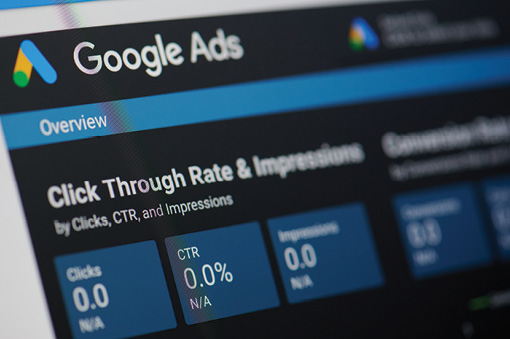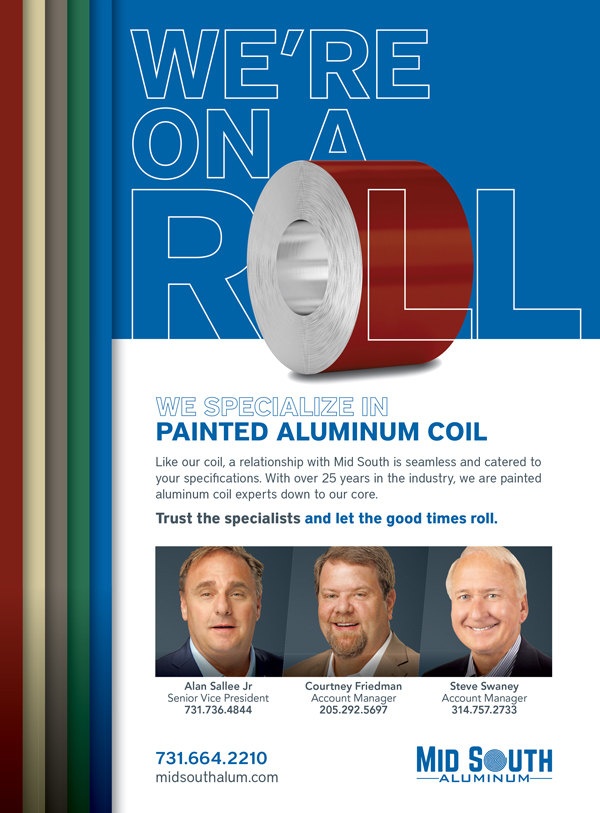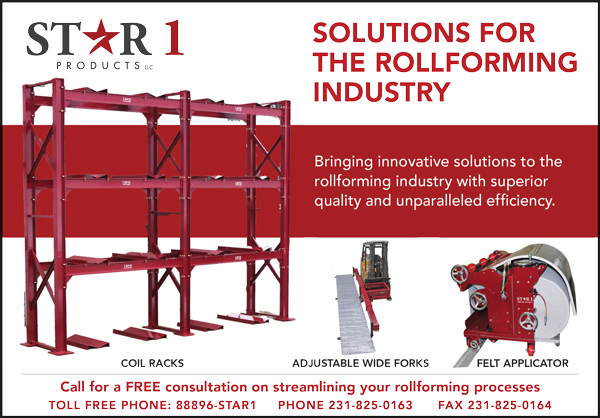Even some website development and computer expenses qualify
By Mark E. Battersby
Growing a roll-forming business today relies on solid communication with potential customers. Without a solid marketing plan, it is very difficult to collect leads, build the operation’s “brand,” or increase sales. As important as traditional marketing has been in the past, digital marketing is quickly surpassing it. And, best of all, tax deductions can substantially reduce the out-of-pocket cost of digital advertising, marketing, and promotion.
According to the IRS, advertising and marketing expenses must only be reasonable and directly related to a roll-forming business in order to be tax deductible. Sponsoring a team named the “Southwest Gutters” or listing the business name in the program of a charity event, is usually evidence the expenditure is deductible. Unfortunately, in addition to neglecting web marketing expenses, many roll formers all-too-often lump advertising, promotions, public relations and other sales support expenses under the “marketing” heading.
VIVA LA DIFFERENCE
Separating advertising and promotion budgets is the first step when reducing costs with tax deductions. In the eyes of the IRS, advertising generally consists of paid, scripted messages directed at potential customers. Promotion is usually defined as paid exposure for the business. Examples of advertising include magazine and newspaper ads, radio and TV spots, billboards, website banner ads, and signage at events. Advertising that does not directly relate to the roof and wall products business’s services or products — such as supporting legislation or promoting a charity — may or may not be tax deductible.
Specifically, advertising expenses include the cost of media buys, expenses associated with creating ads, agency fees and commissions. Promotional expenses are expenditures made by a roll former to make his or her services or products better-known to consumers.
The IRS considers promotion expenses to be tax-deductible as business expenses — provided they are ordinary and necessary. Promotional expenses include fees charged by an event for the roll-forming business to sponsor, signage created for an event, staff time creating and attending events, and fees paid to consultants, event workers or endorsers.
WEB MARKETING AND OTHER EXPENSES
A roll-forming operation’s website, as well as its internet marketing/advertising expenses, are also tax deductible. In fact, many of the website and marketing services contracted for can be deducted in the same year they are incurred. Unfortunately, there are a few services where the cost can be recovered only through the long amortization write-off period.
Marketing via Social Media is becoming increasingly popular in the construction industry, a fact recognized by our tax laws. The expense of Social Media creation and ongoing account management are considered advertising expenses and can be claimed as a tax deduction in the year paid or incurred. Consider a few examples:
- * Google AdWords used to attract new customers or clients instantly; a simple campaign can be setup in minutes and display search results within a couple of hours.
- * Pay-per-click (PPC) campaigns. While AdWords, like the other internet marketing and advertising expenses, the cost for a PPC campaign also falls within the miscellaneous advertising section of the roll forming operation’s tax return.
- * Facebook ad campaigns
- * Twitter ad campaigns
- * Display banner ad campaigns
- * Costs for hiring an agency to conduct any
of these campaigns - * On-Page and Off-Page SEO (Basic and Ongoing), Search Engine Optimization (SEO) campaign results are a long-term campaign to keep your website at the top of search engine result pages, but it takes time if it’s done properly.
- * Link Building
Don’t forget old-fashioned Goodwill Advertising. If a business is expected to benefit in some shape or form from a promotional activity, the cost of institutional or goodwill advertising may be deducted. This is because the motive of advertising activity is to get the name of the roof and wall products, gutters or flashing business in front of the public. Goodwill advertising includes:
- * Promotional activities that ask people to donate for charity
- * Business sponsorship, and
- * Organizing contests and offering rewards or prizes
Unfortunately, labor costs involved in organizing such activities cannot be deducted. Actually, it is necessary that funds be paid in order to record it as advertising expense or a deduction.
- * On the off chance that the website is being used for publicizing, web support costs can be deducted as a promotion cost. In the event that the site is utilized for sales and has an e-commerce option, it is a sales expense and is considered independently. Of course, designing and maintenance costs for even an e-commerce website are deductible.
Naturally, detailed records and receipts for these marketing expenses are strongly recommended. Also, every roll former should understand the IRS’s guidelines when developing and maintaining a website that is often the key ingredient in online advertising and marketing.
WEBSITE DEVELOPMENT COSTS
The IRS has yet to issue formal guidance on the treatment of website development costs. However, informal internal guidance suggests that one appropriate approach is to treat those costs like an item of software and depreciate them over three years.
It is clear, however, that taxpayers who pay large amounts to develop sophisticated sites have been allocating their costs to items such as software development (currently deductible, like research and development costs), utilizing the Section 179 first-year expensing election, and even as currently deductible advertising expenses.
Website content that is not advertising will usually be currently deductible, or written-off over a multi-year period, depending on its useful life. The cost of acquiring a domain name, on the other hand, while considered a capital asset, is not deductible and cannot be depreciated over a period of time.
Fortunately, website design and content are considered fixed assets and qualify as Section 179 first-year expenses and fully deductible. They also may qualify for “bonus depreciation purposes and a 100% write-off. It’s a similar story for depreciable computer software.
In reality, the classification of web design and development services depend on when the work was done, who did it and the specifics of the actual work. If, for example, an outside contractor designs a simple template website for informational purposes it can be capitalized and the expenditures amortized over its “useful life” (usually three years) once put into service. Or, depending on the operation’s accounting practices, the cost could be deductible as an advertising expense in the year it was completed.
Here’s a look at several specific website-related expenditures:
- * Cost for the design of the website by an outside contractor hired for this purpose
- * Cost for the template if purchasing the design pre-made
- * Cost for hosting the site as well as the domain fee
- * Cost for any premium services (such as add-ons or plug-ins for the roll-forming business’s site)
- * Cost for maintenance
- * If a new blog was created and uses freelance bloggers for its content, be sure to keep records of all related expenses because they can often be tax deductions as well.
If the website was purchased, the business is required to amortize the cost over a three-year period. Content or design updates and ongoing maintenance are considered advertising and can be deducted the same year. It is a similar story for hosting, domains, and other similar products that are usually deducted the same year.
Up to $5,000 of so-called “startup” expenses, can be deducted in the first year — even where the website is built before the business opens its doors. While that immediate deduction for startup costs is reduced, dollar-for-dollar when start-up costs exceed $50,000, the balance is recoverable over a 15-year period.
COMPUTERS AND COMPUTER SOFTWARE
As a general rule, software purchased for business use must be depreciated over a 36-month period. When software comes with a computer, and its cost is not separately stated, it’s treated as part of the hardware and depreciated over five years.
However, under Section 179, the cost of a whole computer system (including bundled software) can be written off in the first year so long as the total cost is within Section 179’s $1,040,000 limit.
Software, in order to qualify, must meet all of these general specifications:
- * The software must be financed (only specific types of leases or loans qualify), or purchased outright.
- * The software must be used in the business for an income-producing activity.
- * The software must have a determinable useful life.
- * The software must be expected to last more than one year.
Off-the-shelf computer software that is readily available for purchase by the general public and placed in service during the tax year qualifies for the Section 179 first-year expensing deduction. Depreciable computer software is now also eligible for 100% “bonus” depreciation.
By providing the roll-forming operation’s website with a steady stream of click throughs, email marketing is extremely important in converting prospective customers into paying ones. Best of all, many of the costs associated with web marketing, advertising, and promotion are tax deductible.
It’s important to remember to keep documentation and detailed records of how things were used. Above all, every roll former should always consult with a tax professional to ensure maximum write-offs for all advertising and marketing expenditures. RF



















